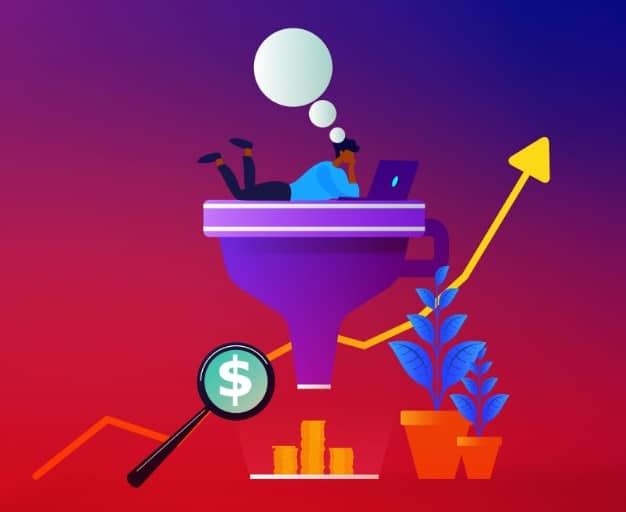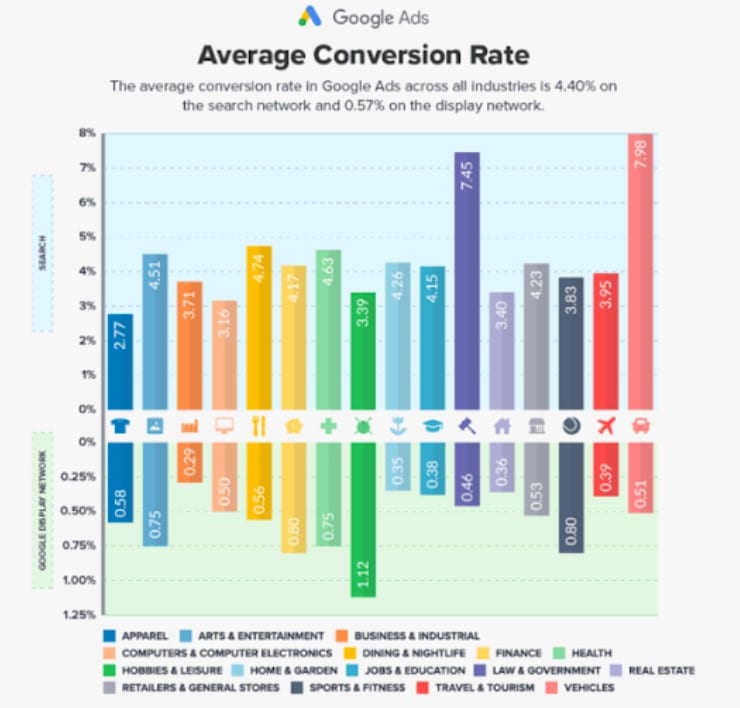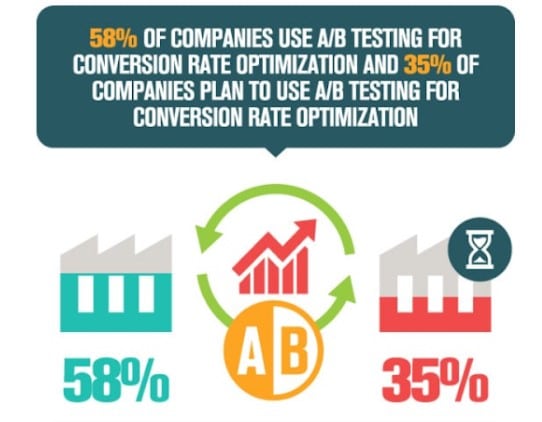So, you’ve put together an in-depth, strategic marketing plan that you love. You’ve included everything from content to link building, SEO, and email marketing. You’ve even got a brilliant influencer marketing plan in place bringing in leads. But, for some reason, even though you’re securing these leads, your conversion rate seems to be stalling. Sound familiar?

Image sourced from vibriefing.com
You’re not alone in facing this challenge. Recent research found that around a quarter (24%) of companies have fallen short of their conversion rate targets, both in terms of qualifying leads and generating revenue from marketing efforts.
So in this guide, we’re giving you the complete lowdown on conversion marketing, including its benefits and some best practices for integrating it into your marketing strategy. Let’s get started.

Conversion marketing is more than being able to generate leads. Essentially, it’s all about boosting the number of people who visit your website and then actually do something you want them to do. Now, typically, we think of conversions as purchases. While this is the main goal, conversions could also be anything that nudges a visitor closer to becoming a paying customer.
Think of it like this. You want people to buy your product or service, right? Sure, that’s the end goal. But before they make a purchase, there are several other actions that could lead them there. They could sign up for your email newsletter, book a demo, or start a free trial.
You want to not only attract visitors to your site but also make sure they take actions that could eventually lead to them using your services. That’s where conversion marketing comes into play. It’s about getting those visitors to take those steps that bring them closer to becoming your loyal customers – whether you’re the marketing manager of a call center thinking about the future of the call center industry, or if you’re a sustainability-focused eCommerce brand selling upcycled items.
3 ways conversion marketing can improve your business
Now, let’s talk about why conversion marketing is your best bet for business (and should definitely be thought about when creating or revising your marketing strategy).
Revamps your digital marketing plan
You’ve spent hours crafting a killer digital marketing strategy, knowing how crucial it is for attracting leads. It’s only natural to want to fine-tune it for better results, right? That’s where conversion marketing comes in, offering a smart solution to polish up your digital processes. It’s all about streamlining your operations, cutting costs, and guiding potential customers smoothly through their journey to conversion.
Imagine working for a B2B payments and banking consultancy. One of your key offerings is a free guide called ‘What is positive pay,” designed to educate businesses on this fraud prevention tool. With conversion marketing, you can tempt potential clients to download this freebie, pulling them into your sales funnel. Through tailored tweaks and personalized content, each download educates and nurtures leads, leading to more conversions and a stronger client base.
Enhances brand loyalty
Conversion marketing is key to building stronger bonds with your audience and enhancing brand loyalty. It’s not just about making sales – it’s about creating memorable experiences that keep customers coming back for more.
By tailoring your approach to meet their needs at every step, you’ll be selling more products or services and building long-lasting relationships. Because when customers feel valued and understood, they’re more likely to stick around, and spread the word about your brand.
Improves customer insights
Conversion marketing gets you into the minds of your customers. With marketing strategies like A/B testing, heat mapping, and analytics tracking, businesses get a front-row seat to understand what makes their audience tick.
Armed with this data, you’re able to make smarter decisions. For instance, if you work at a call center, you could find out that you may need to tweak some of your website layouts or fine-tune email subject lines making them more engaging.
So, instead of a simple subject line like ‘How to calculate contact rate’ it could be more attention-grabbing like “3 secrets to boosting your call center’s performance.
3 steps to crafting winning conversion marketing strategies
Let’s now talk about how you can go about designing conversion marketing strategies that work wonders. Here are some simple steps to get you started.
Step #1: Define the stages of your conversion funnel
First things first, you need to map out your conversion funnel. Think of it as plotting out the journey from “just browsing” to “happy customer”. Now, conversion marketing covers a bunch of actions that turn curious visitors into paying customers. These actions, or touchpoints, are like pit stops along the way. But every business gets to design its own unique journey.

Take a B2B company, for instance. Their conversion funnel might look something like this:
- Check out the website or hit up a landing page
- Fill out a form and snag some cool content
- Book a demo
- Try out a free trial
- Sign up for a plan
- Plan renewals.
Meanwhile, for a B2C online shop, the journey could be more like:
- Pop by the website for a look-see
- Scope out the product page
- Toss some goodies into the cart
- Make that first purchase
- Keep coming back for more shopping sprees.
Step #2: Think about your Key Performance Indicators (KPIs)
Now that you’ve sketched out your conversion funnel, it’s time to get down to the numbers. We’re talking about KPIs—those metrics that tell you how each stage of your funnel is doing.
Say you’re on a mission to boost those purchases on your website. Here are some key metrics you’ll want to keep tabs on:
- Conversion rate: This little gem tells you the percentage of website visitors who take the desired action—like making a purchase. Now, you’ll want to know the average conversion rate for each marketing method you’re using here. For example, if you want to set this KPI for your Google ads, you’ll see that the average conversion rate is 4.40 percent (but this differs from industry to industry). So, you’ll want to stay around that figure.
- Average Order Value (AOV): AOV gives you the average amount customers spend per order. It’s like a sneak peek into your customers’ shopping habits and can help you tailor your marketing strategies accordingly.
- Cart abandonment rate: Ever had someone fill up their cart, only to bail at the last minute? Cart abandonment rate tells you how often this happens.

Image sourced from wordstream.com
These, of course, are just three out of the many metrics you can use. Some other metrics you’ll likely use to check your conversion in other areas may be:
- Customer Acquisition Cost (CAC)
- Return on Investment (ROI)
- Customer retention rate
- Website traffic sources
- Email open and click-through rates.
Step #3: Start using powerful optimization methods
Now that your conversion funnel is mapped out and your KPIs are set, it’s time to start using some potent optimization methods. These tools and techniques will help you fine-tune every aspect of your conversion strategy. Some of our favorites include:
- A/B testing: This method lets you compare two versions of a webpage, email, or ad to see which one performs better. By testing different elements like headlines, images, or CTAs, you can identify what resonates most with your audience and optimize for maximum impact. And, with 58 percent of companies already using this method for testing their conversion rate and 35 percent planning to in the future, it’s clear that marketers recognize just how effective this is in driving results.
- Multivariate testing: With multivariate testing, you can test multiple variations of multiple elements simultaneously. This allows for more complex experiments and deeper insights into what combinations work best for your audience.
- Heat mapping: Ever wished you could see exactly where your visitors are clicking (or not clicking) on your website? That’s heat mapping in a nutshell. It provides visual data on user interactions, revealing hotspots and dead zones. With this information, you can optimize your website layout and design for better engagement and conversion.
- User testing: With this method you get to put yourself in your customers’ shoes with user testing. This involves observing real users as they interact with your website or product, and uncovering usability issues and friction points. By identifying and addressing these barriers, you can create a smoother and more intuitive conversion journey.

Image sourced from invespcro.com
Final thoughts
So there you have it—our complete guide to mastering conversion marketing. From giving you the 411 on the basics to explaining how to do it to improve your business and marketing, we’ve left no stone unturned.
Now, with the knowledge of defining your conversion funnel, identifying those crucial performance indicators, and unleashing the power of optimization methods, you’re ready to take on the world.
So, go ahead, and dazzle the marketing world with your newfound expertise. With conversion marketing on your side, there’s no limit to what you can achieve. Here’s to turning leads into loyal customers and watching your business soar like never before.








